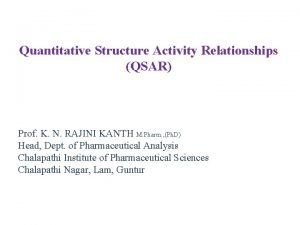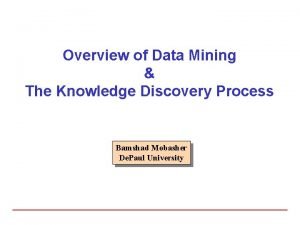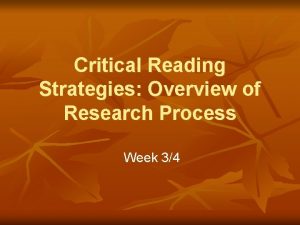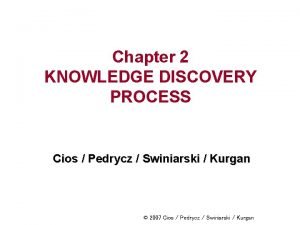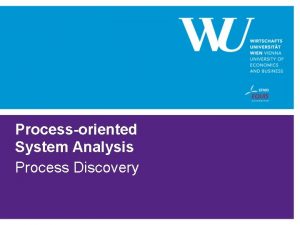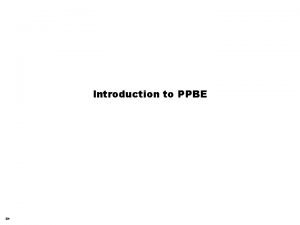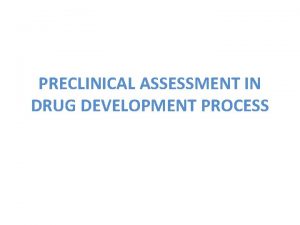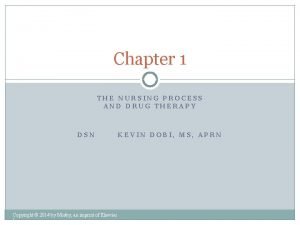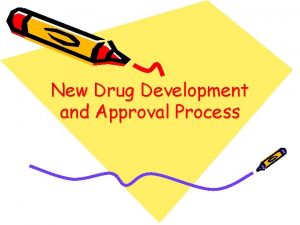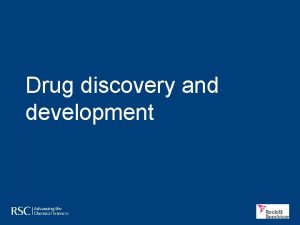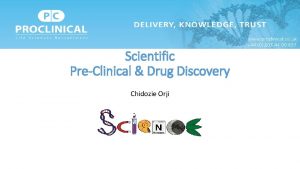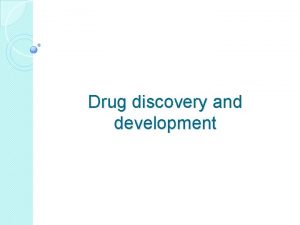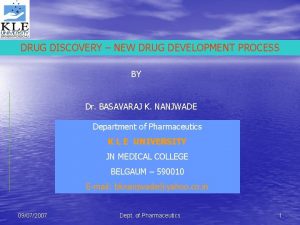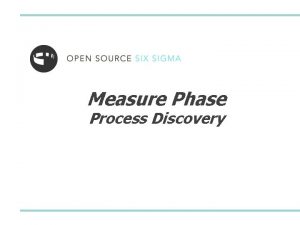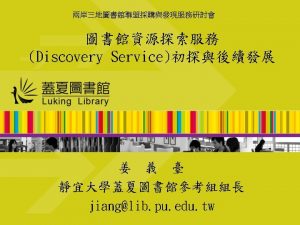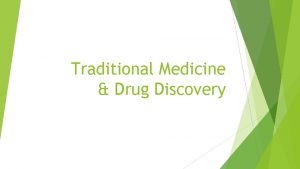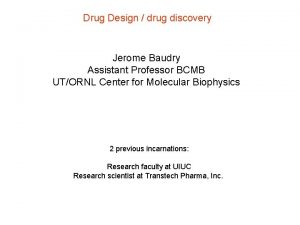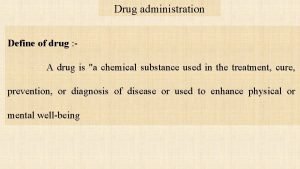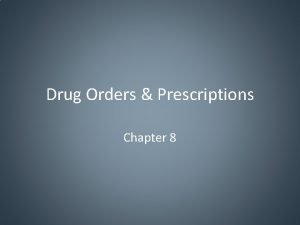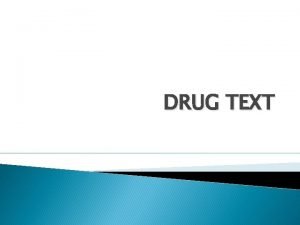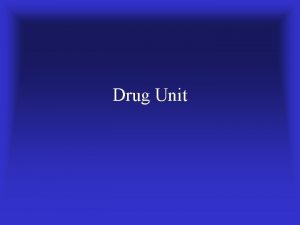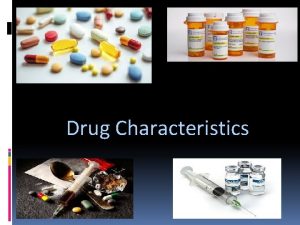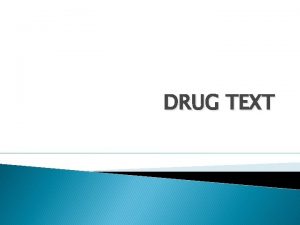Lecture 2 Overview of the Drug Discovery Process




















- Slides: 20

Lecture 2 Overview of the Drug Discovery Process. Target identification and selection. 6/5/2021 1

1. The Drug Discovery Process: • Drug discovery is an expensive and time-consuming. • Retrospective analyses of the pharmaceutical industry during the 1990 s estimate that each new drug in the market takes an average 14 years to develop, costing in the region of $800 million. • In addition one in nine compounds that enters clinical trials makes it to the market. 6/5/2021 2

• For a drug to work, it has to interact with a disease target (e. g. receptor, enzyme or nucleic acid) in our body and intervene in its way ward functions. • An analogy is the lock and key comparison, with the lock being the disease target and the key representing the drug. The correct key has to be found to turn the lock and open the door to treat the disease. 6/5/2021 3

Target Identification. • The starting point for a target-oriented drug-discovery project is to identify a relevant target. • The first requirement in conventional drug discovery is identification of a valid target, a molecule which has a link with the disease of interest such that pharmacological intervention would be expected to cure the disease or ameliorate its symptoms. 6/5/2021 4

There a number of techniques used for target identification. • Radio ligand binding was a common technique until recently. • Now DNA microarrays, expressed sequence tags are used. 6/5/2021 5

Radio ligand Binding: • The classic method to discover drug targets or receptors is to bind the potential receptors with radio ligands, so that targets can be picked out from a pool of other receptors. • Bound receptors are then separated from the radio ligands and sequenced. • Potential drug molecules are then studied with these receptors or their nucleotide sequences to determine their interactions in terms of biochemical and functional properties. 6/5/2021 6

DNA Microarray: • DNA microarray, also known as DNA or gene chips, is a technology to investigate how genes interact with one another and how they control biological mechanisms in the body. • The gene expression profile is dynamic and responds to external stimuli rapidly. By measuring the expression profile, scientists can assess the clues for the regulatory mechanisms, biochemical pathways, and cellular functions. • In this way, microarrays enable scientists to find out the target genes that cause disease. 6/5/2021 7

Microarrays: • To use the microarray, a known sequence of short DNA is printed on a solid support of membrane or glass slide. • From healthy and diseased cells, m. RNAs are isolated. • The m. RNAs are used to generate complementary DNAs (c. DNAs). • Fluorescent tags are attached to the c. DNAs, and the c. DNAs are then mixed and incubated with the microarray supports (slides). 6/5/2021 8

Microarray slides (Photo courtesy of Thermo Fisher Scientific). 6/5/2021 9

Selecting a drug target 1 - Drug targets • Once a therapeutic area has been identified, the next stage is to identify a suitable drug target (e. g. receptor, enzyme or nucleic acid) • Understanding which bio macromolecules are involved in a particular disease state is very important. This will allow the medicinal chemist whether agonist or antagonist to be designed for a particular receptor or whether inhibitors should be designed for a particular enzyme. 6/5/2021 10

Receptor Membrane Agonist Biochemical reactions activated Agonist binding to receptor initiates biochemical reactions Biochemical reactions blocked Membrane Antagonist 6/5/2021 Antagonist binding to receptor blocks biochemical reactions. 11

Selecting a drug target 2 - Discovering drug targets • If a drug or a poison produces a biological effect, there must be a molecular target for that agent in the body. • In the past, the discovery of drug targets depends on finding the drug first. Then, natural chemical messengers started to be discovered. • But many targets still stay hidden (orphan receptors i. e, novel receptors whose endogenous ligand is unknown ) and their chemical messengers are also unknown. 6/5/2021 12

The challenge is to find a chemical that will interact with these targets in order to find their function and whether they will be suitable as drug targets. This is one of the main driving forces behind the rapidly expanding area of Combinatorial synthesis (synthesis of a large number of compounds in a short period of time using different reagents and starting material and are tested for activity. ) 6/5/2021 13

Selecting a drug target 3 - Target specificity and selectivity between species • Target specificity and selectivity is a crucial factor in modern medicinal chemistry research. • The more the selective a drug is for its target, the less chance that it will interact with different targets and have less undesirable side effects. • For example, penicillin target an enzyme involved in bacterial cell wall biosynthesis. Mammalian cells does not have a cell wall, so this enzyme is absent in human cells and penicillin has few side effects. 6/5/2021 14

Selecting a drug target 4 -Target specificity and selectivity within the body • Selectivity is also important for drug acting on targets within the body. • Enzyme inhibitors should only inhibit the target enzyme and not some other enzyme. 6/5/2021 15

Target Validation: After a drug target has been identified, a rigorous evaluation must occur to demonstrate that modulation of the target will have the desired therapeutic effect. This involves intensive in vitro, as well as in vivo studies that provide information on the effects of biotherapeutic intervention. 2/28/2011 16

Isothermal Titration Calorimetry (ITC) can play a critical role in the determination of the mechanism of action of a specified target pathway. It is impossible to screen for unknown biotherapeutic targets. ITC measures the natural heat generated or absorbed in any biomolecular interaction. There is no requirement for any prior knowledge of the binding partners, substrates or other cofactors. 2/28/2011 17

* Isothermal titration calorimetry (ITC) is a physical technique used to determine thermodynamic parameters of interactions in solution. * It is most often used to study the binding of small molecules (such as medicinal compounds) to larger macromolecules (proteins, DNA etc. ). 2/28/2011 18

The Drug Discovery Process database /genes protein chemical targets diversity identify ‘hit’ optimize ‘hit’ structure test safety/efficacy animals humans The aim is to translate new information into new therapies 6/5/2021 19

Different Method of Discovering New Chemical Entities (NCE). Method Number of potential Comment compounds Rational design 10– 1, 000 s Actual synthesis Combinatorial synthesis 1, 000– 1, 000 s Actual synthesis Chemical library 1, 000 s Many compounds still Natural products Proprietary undiscovered 1, 000 s Owned by individual companies Virtual library 6/5/2021 1, 000, 000 s Software generated 20
 Qsar notes
Qsar notes Nature reviews drug discovery
Nature reviews drug discovery Example of substitution with exhausted drug is
Example of substitution with exhausted drug is Computer-aided drug design lecture notes
Computer-aided drug design lecture notes 01:640:244 lecture notes - lecture 15: plat, idah, farad
01:640:244 lecture notes - lecture 15: plat, idah, farad Active critical reading
Active critical reading Knowledge discovery process
Knowledge discovery process Process of discovery in critical reading
Process of discovery in critical reading Knowledge discovery process
Knowledge discovery process Bpm discovery
Bpm discovery Kdd process
Kdd process Trial balance junior cert
Trial balance junior cert What is ppbe
What is ppbe What is preclinical
What is preclinical Nursing process in drug therapy
Nursing process in drug therapy Abbreviated new drug application
Abbreviated new drug application Hát kết hợp bộ gõ cơ thể
Hát kết hợp bộ gõ cơ thể Slidetodoc
Slidetodoc Bổ thể
Bổ thể Tỉ lệ cơ thể trẻ em
Tỉ lệ cơ thể trẻ em Gấu đi như thế nào
Gấu đi như thế nào
